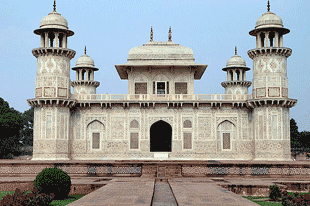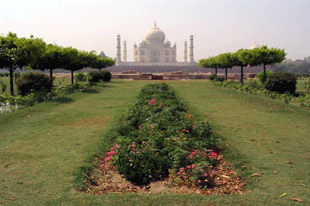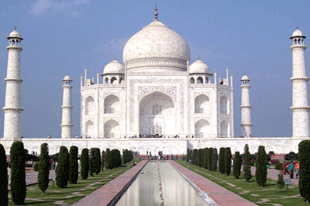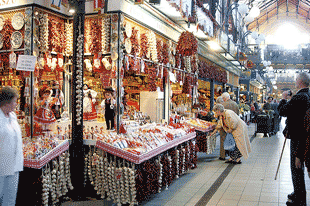Agra, India
Situated at a distance 60 km from Mathura and 205 km from Delhi, Agra is a beautiful city enjoying a fusion of Indian and Persian architectures. The city was founded by Badal Singh in 1475. Agra is the city of the Taj Mahal (symbol of undying love) and features some of the finest historical structures and palaces of the Mughal era. The city is visited by large number of tourists every year.
They come here to have a glimpse of the charming Taj Mahal and other heritage sites from all over the world.Agra city is home to three UNESCO World Heritage Sites, which are Agra Fort, Taj Mahal and Fatehpur Sikri. However, Taj Mahal is the priority of all the tourists visiting Agra. If you are visiting Agra for the first time, you may find it a bit crowded and noisy. However, the glorious crafted monuments of Agra can win your heart and you may be amazed with their sheer magnificence and glory. A visit to Agra is going be a memorable experience for the visitors and they will get to explore lots of sightseeing places in Agra on their trip.
Visit in Agra
Being a City of Taj, Agra is home to many beautiful constructions and monuments. There are numerous sightseeing places in Agra that you must visit on your Agra tour. Palaces, forts and tombs are the main tourist attractions in Agra that one can explore during their city visit. Explore some of the top places to see in Agra.
Enjoying a height of 20 meters and circumference of 2.5 kms, Agra Fort is surrounded by a moat. It is an important structure and a dominating gateway of Agra. The fort features magnificent towers, citadels and ramparts along with few of the most splendid and subtle palaces of red sandstone and white marble. Some of the prominent structures inside the fort are Jahangir Mahal, Diwan-e-Aam, Sheesh Mahal, and Diwan-e-Khas.
It is the first tomb in India, which is constructed using marble stones. Itmad ud Daula is actually a mausoleum overlooking the Yamuna River. This pure white and elaborately carved tomb is a real Islamic style of architecture. With arched entrances, octagonal shaped towers, closed kiosk on the top and canopies, the fort shows a confluence of India and Persian. Itmad-ud-Daula appears like a jewel box positioned over a garden. It is also known as ‘Baby Taj’. Itmad-ud-Daula is a mausoleum, which was commissioned by Noor Jahan for her father Mirza Ghiyas Beg.
Chini-ka-Rauza is a milestone in Indo-Persian architecture and the very first architecture in India exclusively festooned by the glazed tile works. It is in fact a small mausoleum overlooking the River Yamuna and a superb example of pure and perfect Persian architecture.
Nothing describes Agra better than Taj Mahal. A city has never been so reliant on a monument to create its identity and a monument was not so beautiful ever. Taj Mahal symbolizes Agra by making it a city of grandeurs. Being the symbol of undying love, Taj Mahal enjoys a timeless beauty. It is one of Eighth Wonders of the World, which continues to enthrall many artists and tourists. Built using white marble, Taj Mahal is located on the banks of the River Yamuna in Agra and looks picture perfect. Visiting Taj Mahal at night in moonlight is a beautiful experience. You will be delighted with this experience and would never forget it.
Mehtab Bagh is laid across Yamuna’s south bank. It is spread over an area of 25-acres and attracts visitors with its magnificence and greenery. An infiltrate technology moved from Iran has been applied to blossom the Mehtab Bagh.
Located opposite of the Agra fort, Jama Masjid overlooks the Agra Fort Railway Station. It is also known as the Jami Masjid or "Friday Mosque". This is one of the largest mosques in India built by Mughal emperor, Shahjahan in 1648.
It is the mausoleum of Mariam-uz-Zamani, the Hindu wife of the Mughal Emperor Akbar. The tomb was built by Emperor Jahangir, in memory of his mother Mariam-uz-Zamani. The tomb is situated in Sikandra, a suburb of Agra.
It is an important architectural masterpiece of Mughal era. The tomb was built between year 1605 and 1613. The external entrance of the road imitates the Buland Darwaja at Fatehpur Sikri.
It is a historical Sikh pilgrimage center, which is built in the memory of 9th Guru Sri Guru Tegh Bahudar Ji. It is located near Sikandra. The holy place was built on the place where the Guru Tegh Bahadur voluntarily got arrested by Mughal Emperor, Aurangazeb. The place is visited by a number of devotees every year.
It is the oldest Mughal Garden in India, which was originally built by the Mughal Emperor Babur in 1528. Paths and canals divide the garden to symbolize the Islamic ideal of paradise. The garden has several water courses and fountains.
Situated in the compound of Agra Fort, Moti Masjid was built by Emperor Shah Jahan. This mosque is visited by a number of travelers. The shiny domes of the mosque are built using off-white marble that enhance its beauty and give it a pearl like shine.
It is one of the ancient temples of the city. The main deity of the temple is Lord Shiva. One can find here a number of devotees coming here to perform prayers and worshiping. The shivlingam kept in the temple is said to be founded by Lord Shiva himself.
Fatehpur Sikri is an imperial city and one of topmost excursions of Agra. Emperor Akbar founded this city, to serve together with Agra, as the imperial capital of Mughal Empire. The city is situated amidst barren ridge presently and was established by Emperor Akbar. This fascinating city is evidence to the Mughal civilization and offers a unique architectural collection of very high quality. The literal meaning of Fatehpur Sikri is the City of Victory and it is a World Heritage Site by UNESCO. One can come across attractions like Buland Darwaza, Fatehpur Sikri Fort, Panch Mahal and Salim Chishti Fort.
Agra, India

Mid-March to June
Temperature:30°C- 45°C

July to September
Annual rainfall -Average annual -400 mms.

Last November to February
Temperature:12°C-15°C
Sights of Agra



